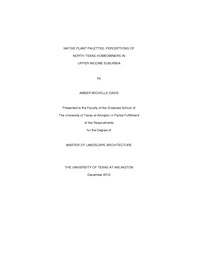
ATTENTION: The works hosted here are being migrated to a new repository that will consolidate resources, improve discoverability, and better show UTA's research impact on the global community. We will update authors as the migration progresses. Please see MavMatrix for more information.
Show simple item record
| dc.contributor.author | Davis, Amber Michelle | en_US |
| dc.date.accessioned | 2013-03-20T19:11:07Z | |
| dc.date.available | 2013-03-20T19:11:07Z | |
| dc.date.issued | 2013-03-20 | |
| dc.date.submitted | January 2012 | en_US |
| dc.identifier.other | DISS-12013 | en_US |
| dc.identifier.uri | http://hdl.handle.net/10106/11526 | |
| dc.description.abstract | This study examines the perceptions of upper-income homeowners in North Texas regarding their knowledge of native plant palettes and their commitment to using them in their residential landscapes. Literature on the topic highlights different perspectives on the actual definition of `native' plants. However, for the purpose of this study a `native plant palette' refers to the use of a plant species that "occurs naturally in a particular region, ecosystem or habitat without direct or indirect human intervention" and in return helps support its surrounding ecological community (Tallamy 2009; US National Arboretum 2006, pg. 1)."Current literature on homeowners' perceptions of native plants is limited. Therefore, this study investigates factors influencing residential landscapes in order to understand homeowners' plant choices in present-day suburbia. In addition, expert opinion reflects the current debate between native plants versus non-native plants in the landscape. By identifying homeowners' perceptions, landscape professionals will be able to market and design future proposals to homeowners' expressed needs and wants.This study employs qualitative research methods using in-depth interviews to gain an understanding of a participant's view on the topic (Taylor and Bogdan 1998). The participants of the study included volunteers, primarily elected officials due to privacy concerns, and residents of homeowner's associations in the following four suburban neighborhoods in North Texas: Montgomery Farm in Allen, TX; Stone Lakes in Southlake, TX; Bakers Branch in Flower Mound, TX; and Wellington in Flower Mound, TX. Overall, respondent selection is part of a grander categorization according to climatic division, North Central Texas. The North Central Texas climatic division represents the cross-timbers and backland prairie regions (National Agriculture Statistics Service 2012). Although the regions are diverse in native plant representation, this study does not focus on regions, rather homeowners' perceptions of native plants in general. Additional narrowing of participants includes suburb popularity, proximity, household income status, and access.The findings collected from respondents revealed limited knowledge from informants regarding native plant palettes. Interview results also illustrated a positive opinion among respondents regarding native plants in residential landscapes to accomplish needs such as water conservation and plant longevity. However, in order to commit to native plants, homeowners request the aid of design professionals to accomplish aesthetic goals. This request is important to the landscape architecture profession as they are the professionals who will adapt future native plant design proposals to meet the needs and wants of the homeowner. | en_US |
| dc.description.sponsorship | Hopman, David | en_US |
| dc.language.iso | en | en_US |
| dc.publisher | Landscape Architecture | en_US |
| dc.title | Native Plant Palettes: Perceptions Of North Texas Homeowners In Upper-income Suburbia | en_US |
| dc.type | M.L.A. | en_US |
| dc.contributor.committeeChair | Hopman, David | en_US |
| dc.degree.department | Landscape Architecture | en_US |
| dc.degree.discipline | Landscape Architecture | en_US |
| dc.degree.grantor | University of Texas at Arlington | en_US |
| dc.degree.level | masters | en_US |
| dc.degree.name | M.L.A. | en_US |
Files in this item
- Name:
- Davis_uta_2502M_12013.pdf
- Size:
- 1.419Mb
- Format:
- PDF
This item appears in the following Collection(s)
Show simple item record


